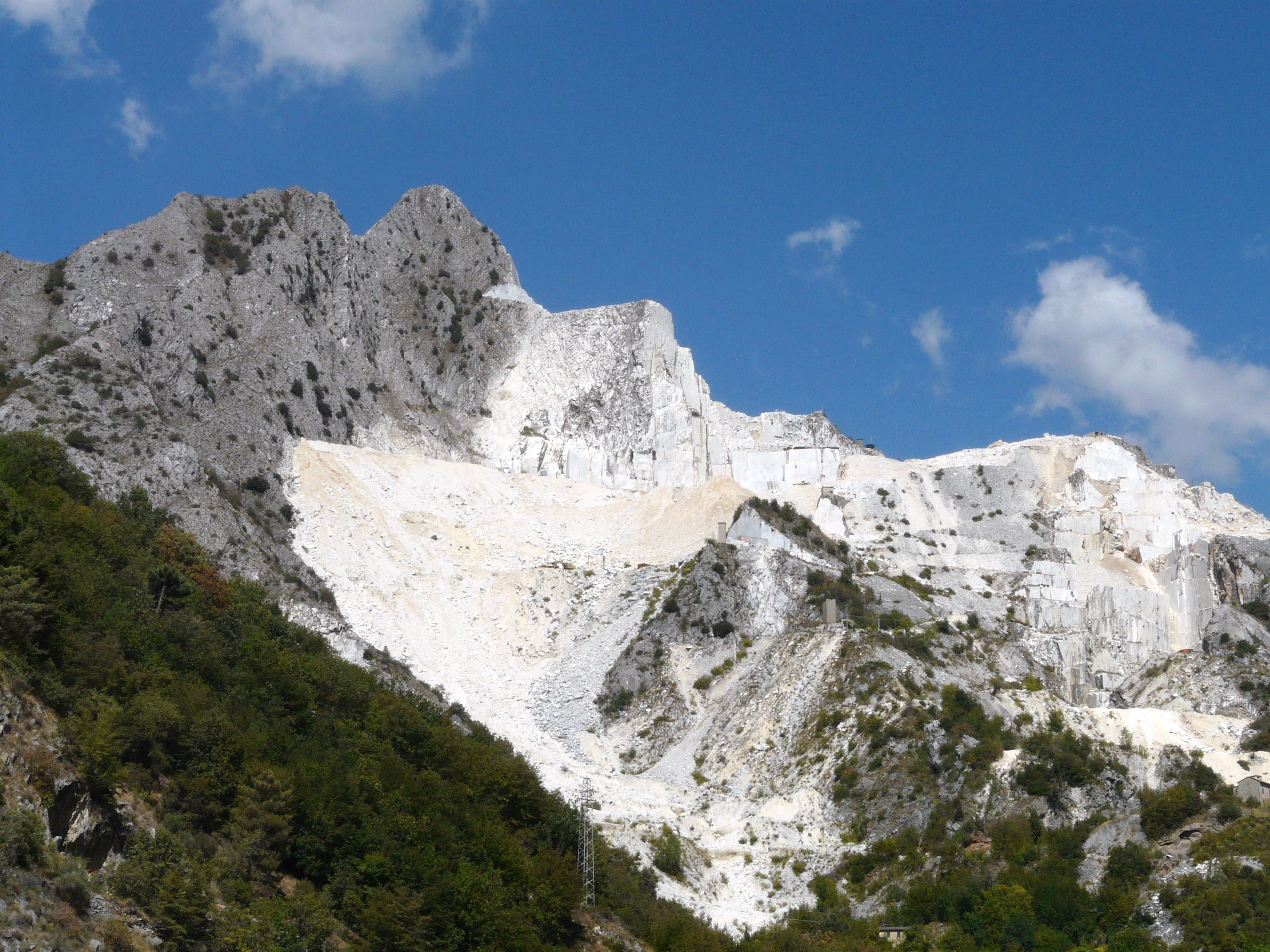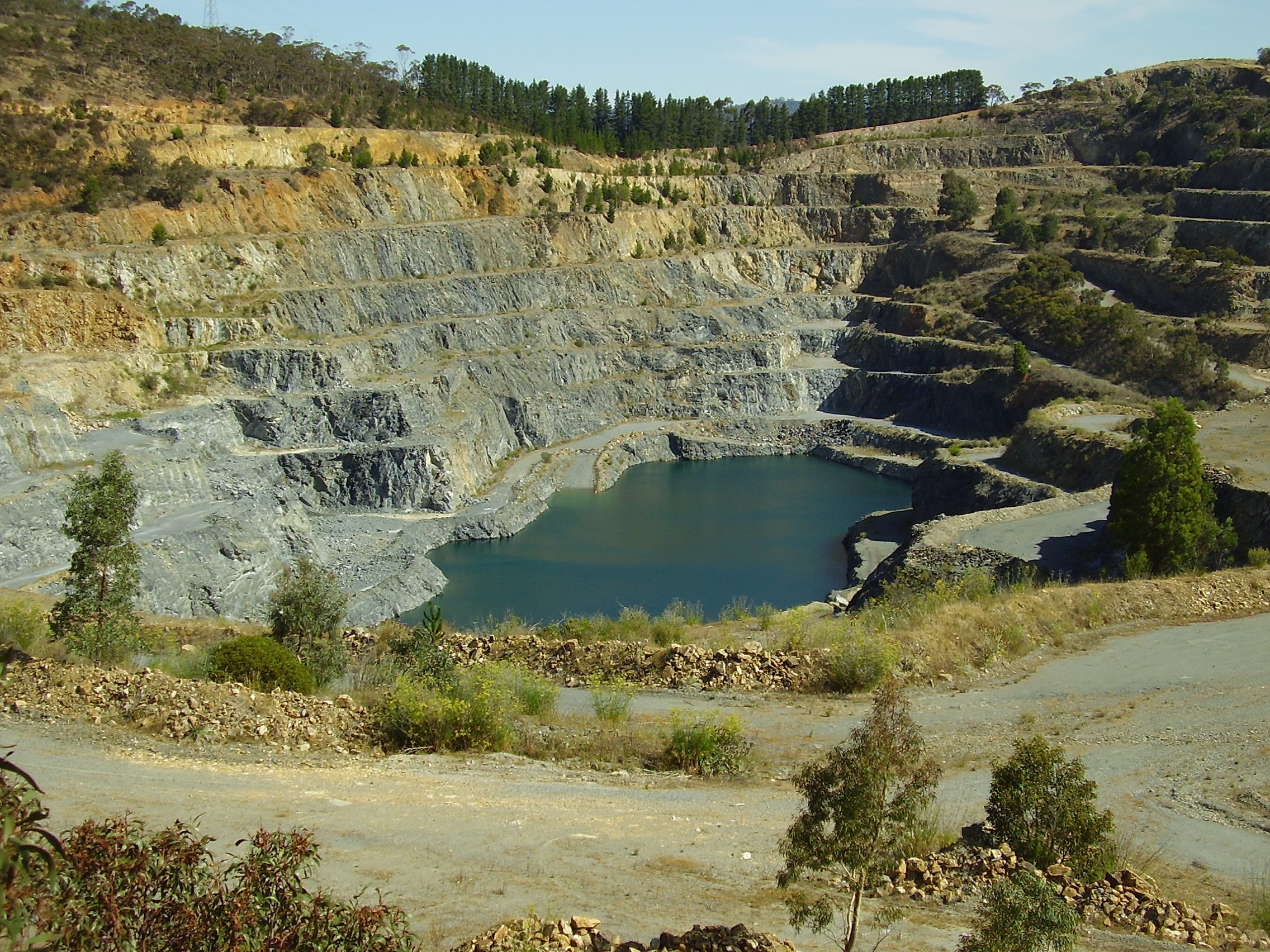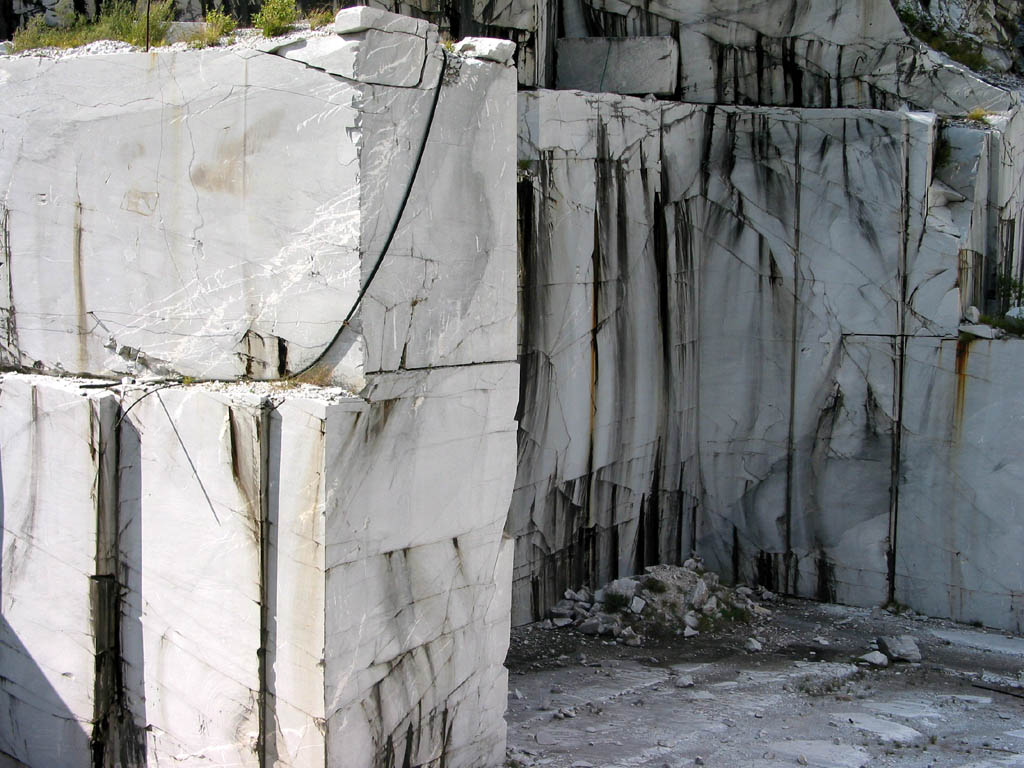quarries on:
[Wikipedia]
[Google]
[Amazon]




 A quarry is a type of
A quarry is a type of


 Quarries in level areas with shallow
Quarries in level areas with shallow
Quarries


 A quarry is a type of
A quarry is a type of open-pit mine
Open-pit mining, also known as open-cast or open-cut mining and in larger contexts mega-mining, is a surface mining technique that extracts rock or minerals from the earth.
Open-pit mines are used when deposits of commercially useful ore or ...
in which dimension stone
Dimension stone is natural stone or Rock (geology), rock that has been selected and finished (e.g., trimmed, cut, drilled or ground) to specific sizes or shapes. Color, Texture (geology), texture and pattern, and surface finish of the stone are ...
, rock, construction aggregate
Construction aggregate, or simply aggregate, is a broad category of coarse- to medium-grained particulate material used in construction. Traditionally, it includes natural materials such as sand, gravel, crushed stone. As with other types of ag ...
, riprap, sand
Sand is a granular material composed of finely divided mineral particles. Sand has various compositions but is usually defined by its grain size. Sand grains are smaller than gravel and coarser than silt. Sand can also refer to a textural ...
, gravel
Gravel () is a loose aggregation of rock fragments. Gravel occurs naturally on Earth as a result of sedimentation, sedimentary and erosion, erosive geological processes; it is also produced in large quantities commercially as crushed stone.
Gr ...
, or slate
Slate is a fine-grained, foliated, homogeneous, metamorphic rock derived from an original shale-type sedimentary rock composed of clay or volcanic ash through low-grade, regional metamorphism. It is the finest-grained foliated metamorphic ro ...
is excavated from the ground. The operation of quarries is regulated in some jurisdictions to manage their safety risks and reduce their environmental impact.
The word ''quarry'' can also include the underground quarrying for stone, such as Bath stone
Bath Stone is an oolitic limestone comprising granular fragments of calcium carbonate originally obtained from the Middle Jurassic aged Great Oolite Group of the Combe Down and Bathampton Down Mines under Combe Down, Somerset, England. Its h ...
.
History
For thousands of years, only hand tools had been used in quarries. In the eighteenth century, the use of drilling and blasting operations was mastered.Types of rock
Types of rock extracted from quarries include: *Chalk
Chalk is a soft, white, porous, sedimentary carbonate rock. It is a form of limestone composed of the mineral calcite and originally formed deep under the sea by the compression of microscopic plankton that had settled to the sea floor. Ch ...
*China clay
Kaolinite ( ; also called kaolin) is a clay mineral, with the chemical composition aluminium, Al2Silicon, Si2Oxygen, O5(hydroxide, OH)4. It is a layered silicate mineral, with one tetrahedron, tetrahedral sheet of silica () linked through oxygen ...
*Cinder
Cinder or Cinders may refer to:
In general
* Ember, also called cinder
* Ash, also called cinder
* Scoria, or cinder, a type of volcanic rock
In computing
* Cinder (programming library), a C++ programming library for visualization
*Cinder, Ope ...
*Clay
Clay is a type of fine-grained natural soil material containing clay minerals (hydrous aluminium phyllosilicates, e.g. kaolinite, ). Most pure clay minerals are white or light-coloured, but natural clays show a variety of colours from impuriti ...
*Coal
Coal is a combustible black or brownish-black sedimentary rock, formed as rock strata called coal seams. Coal is mostly carbon with variable amounts of other Chemical element, elements, chiefly hydrogen, sulfur, oxygen, and nitrogen.
Coal i ...
*Construction aggregate
Construction aggregate, or simply aggregate, is a broad category of coarse- to medium-grained particulate material used in construction. Traditionally, it includes natural materials such as sand, gravel, crushed stone. As with other types of ag ...
(sand
Sand is a granular material composed of finely divided mineral particles. Sand has various compositions but is usually defined by its grain size. Sand grains are smaller than gravel and coarser than silt. Sand can also refer to a textural ...
and gravel
Gravel () is a loose aggregation of rock fragments. Gravel occurs naturally on Earth as a result of sedimentation, sedimentary and erosion, erosive geological processes; it is also produced in large quantities commercially as crushed stone.
Gr ...
)
*Coquina
Coquina () is a sedimentary rock that is composed either wholly or almost entirely of the transported, abraded, and mechanically sorted fragments of mollusks, trilobites, brachiopods, or other invertebrates. The term ''coquina'' comes from the S ...
*Diabase
Diabase (), also called dolerite () or microgabbro,
is a mafic, holocrystalline, subvolcanic rock equivalent to volcanic basalt or plutonic gabbro. Diabase dikes and sills are typically shallow intrusive bodies and often exhibit fine-gra ...
*Gabbro
Gabbro ( ) is a phaneritic (coarse-grained and magnesium- and iron-rich), mafic intrusive igneous rock formed from the slow cooling magma into a holocrystalline mass deep beneath the Earth's surface. Slow-cooling, coarse-grained gabbro is ch ...
*Granite
Granite ( ) is a coarse-grained (phanerite, phaneritic) intrusive rock, intrusive igneous rock composed mostly of quartz, alkali feldspar, and plagioclase. It forms from magma with a high content of silica and alkali metal oxides that slowly coo ...
*Gritstone
Gritstone or grit is a hard, coarse-grained, siliceous sandstone. This term is especially applied to such sandstones that are quarried for building material. British gritstone was used for millstones to mill flour, to grind wood into pulp for ...
*Gypsum
Gypsum is a soft sulfate mineral composed of calcium sulfate Hydrate, dihydrate, with the chemical formula . It is widely mined and is used as a fertilizer and as the main constituent in many forms of plaster, drywall and blackboard or sidewalk ...
*Limestone
Limestone is a type of carbonate rock, carbonate sedimentary rock which is the main source of the material Lime (material), lime. It is composed mostly of the minerals calcite and aragonite, which are different Polymorphism (materials science) ...
*Marble
Marble is a metamorphic rock consisting of carbonate minerals (most commonly calcite (CaCO3) or Dolomite (mineral), dolomite (CaMg(CO3)2) that have recrystallized under the influence of heat and pressure. It has a crystalline texture, and is ty ...
*Ore
Ore is natural rock or sediment that contains one or more valuable minerals, typically including metals, concentrated above background levels, and that is economically viable to mine and process. The grade of ore refers to the concentration ...
s
*Phosphate rock
Phosphorite, phosphate rock or rock phosphate is a non- detrital sedimentary rock that contains high amounts of phosphate minerals. The phosphate content of phosphorite (or grade of phosphate rock) varies greatly, from 4% to 20% phosphorus pentox ...
*Quartz
Quartz is a hard, crystalline mineral composed of silica (silicon dioxide). The Atom, atoms are linked in a continuous framework of SiO4 silicon–oxygen Tetrahedral molecular geometry, tetrahedra, with each oxygen being shared between two tet ...
*Sandstone
Sandstone is a Clastic rock#Sedimentary clastic rocks, clastic sedimentary rock composed mainly of grain size, sand-sized (0.0625 to 2 mm) silicate mineral, silicate grains, Cementation (geology), cemented together by another mineral. Sand ...
*Slate
Slate is a fine-grained, foliated, homogeneous, metamorphic rock derived from an original shale-type sedimentary rock composed of clay or volcanic ash through low-grade, regional metamorphism. It is the finest-grained foliated metamorphic ro ...
*Travertine
Travertine ( ) is a form of terrestrial limestone deposited around mineral springs, especially hot springs. It often has a fibrous or concentric appearance and exists in white, tan, cream-colored, and rusty varieties. It is formed by a process ...

Methods of quarrying
The method of removal of stones from their natural bed by using different operations is called quarrying. Methods of quarrying include: *a) Digging – This method is used when the quarry consists of small and soft pieces of stones. *b) Heating – This method is used when the natural rock bed is horizontal and small in thickness. *c) Wedging –This method is used when the hard rock consists of natural fissure. When natural fissures are absent then artificial fissures are prepared by drilling holes. *d) Blasting – It is the process of removal of stones with the help of controlled explosives is filled in the holes of the stones. Line of least resistance plays very important role in the blasting process. Following steps are used in the blasting process; *1)Drilling
Drilling is a cutting process where a drill bit is spun to cut a hole of circular cross section (geometry), cross-section in solid materials. The drill bit is usually a rotary Cutting tool (machining), cutting tool, often multi-point. The bit i ...
holes – Blast holes are drilled by using drilling machines.
*2) Charging – Explosive powders are fed into the cleaned & dried blast holes.
*3) Tamping – The remaining portion of the blast holes are filled by clay, ash, fuse and wirings.
*4) Firing –The fuses of blasting holes are fired by using electrical power supply or match sticks.
Slabs
Many quarry stones such asmarble
Marble is a metamorphic rock consisting of carbonate minerals (most commonly calcite (CaCO3) or Dolomite (mineral), dolomite (CaMg(CO3)2) that have recrystallized under the influence of heat and pressure. It has a crystalline texture, and is ty ...
, granite
Granite ( ) is a coarse-grained (phanerite, phaneritic) intrusive rock, intrusive igneous rock composed mostly of quartz, alkali feldspar, and plagioclase. It forms from magma with a high content of silica and alkali metal oxides that slowly coo ...
, limestone
Limestone is a type of carbonate rock, carbonate sedimentary rock which is the main source of the material Lime (material), lime. It is composed mostly of the minerals calcite and aragonite, which are different Polymorphism (materials science) ...
, and sandstone
Sandstone is a Clastic rock#Sedimentary clastic rocks, clastic sedimentary rock composed mainly of grain size, sand-sized (0.0625 to 2 mm) silicate mineral, silicate grains, Cementation (geology), cemented together by another mineral. Sand ...
are cut into larger slabs and removed from the quarry. The surfaces are polished and finished with varying degrees of sheen or luster. Polished slabs are often cut into tile
Tiles are usually thin, square or rectangular coverings manufactured from hard-wearing material such as ceramic, Rock (geology), stone, metal, baked clay, or even glass. They are generally fixed in place in an array to cover roofs, floors, wal ...
s or countertops and installed in many kinds of residential and commercial properties. Natural stone quarried from the earth is often considered a luxury and tends to be a highly durable surface, thus highly desirable.
Problems
groundwater
Groundwater is the water present beneath Earth's surface in rock and Pore space in soil, soil pore spaces and in the fractures of stratum, rock formations. About 30 percent of all readily available fresh water in the world is groundwater. A unit ...
or which are located close to surface water often have engineering
Engineering is the practice of using natural science, mathematics, and the engineering design process to Problem solving#Engineering, solve problems within technology, increase efficiency and productivity, and improve Systems engineering, s ...
problems with drainage
Drainage is the natural or artificial removal of a surface's water and sub-surface water from an area with excess water. The internal drainage of most agricultural soils can prevent severe waterlogging (anaerobic conditions that harm root gro ...
. Generally the water is removed by pumping while the quarry is operational, but for high inflows more complex approaches may be required. For example, the Coquina quarry is excavated to more than below sea level.
To reduce surface leakage, a moat
A moat is a deep, broad ditch dug around a castle, fortification, building, or town, historically to provide it with a preliminary line of defence. Moats can be dry or filled with water. In some places, moats evolved into more extensive water d ...
lined with clay
Clay is a type of fine-grained natural soil material containing clay minerals (hydrous aluminium phyllosilicates, e.g. kaolinite, ). Most pure clay minerals are white or light-coloured, but natural clays show a variety of colours from impuriti ...
was constructed around the entire quarry. Groundwater
Groundwater is the water present beneath Earth's surface in rock and Pore space in soil, soil pore spaces and in the fractures of stratum, rock formations. About 30 percent of all readily available fresh water in the world is groundwater. A unit ...
entering the pit is pumped up into the moat. As a quarry becomes deeper, water inflows generally increase and it also becomes more expensive to lift the water higher during removal; this can become the limiting factor in quarry depth. Some water-filled quarries are worked from beneath the water, by dredging.
Many people and municipalities consider quarries to be eyesores and require various abatement methods to address problems with noise, dust, and appearance. One of the more effective and famous examples of successful quarry restoration is Butchart Gardens in Victoria, British Columbia, Canada.
A further problem is pollution of roads from trucks leaving the quarries. To control and restrain the pollution of public roads, wheel washing systems are becoming more common.
Quarry lakes
Many quarries naturally fill with water after abandonment and becomelake
A lake is often a naturally occurring, relatively large and fixed body of water on or near the Earth's surface. It is localized in a basin or interconnected basins surrounded by dry land. Lakes lie completely on land and are separate from ...
s. Others are made into landfill
A landfill is a site for the disposal of waste materials. It is the oldest and most common form of waste disposal, although the systematic burial of waste with daily, intermediate and final covers only began in the 1940s. In the past, waste was ...
s.
Water-filled quarries can be very deep, often or more, and surprisingly cold, so swimming in quarry lakes is generally not recommended. Unexpectedly cold water can cause a swimmer's muscles to suddenly weaken; it can also cause shock and even hypothermia
Hypothermia is defined as a body core temperature below in humans. Symptoms depend on the temperature. In mild hypothermia, there is shivering and mental confusion. In moderate hypothermia, shivering stops and confusion increases. In severe ...
. Though quarry water is often very clear, submerged quarry stones, abandoned equipment, dead animals and strong currents make diving into these quarries extremely dangerous. Several people drown in quarries each year. However, many inactive quarries are converted into safe swimming sites.
Such lakes, even lakes within active quarries, can provide important habitat for animals.
See also
* List of quarries * List of quarries in the United States *Clay pit
A clay pit is a quarry or Mining, mine for the extraction of clay, which is generally used for manufacturing pottery, bricks or Portland cement. Quarries where clay is mined to make bricks are sometimes called brick pits.
A brickyard or brickwor ...
*Coal mining
Coal mining is the process of resource extraction, extracting coal from the ground or from a mine. Coal is valued for its Energy value of coal, energy content and since the 1880s has been widely used to Electricity generation, generate electr ...
* Collecting fossils
* Fair Stone standard
* Gravel pit
*List of minerals
This is a list of minerals which have Wikipedia articles.
Minerals are distinguished by various chemical and physical properties. Differences in chemical composition and crystal structure distinguish the various ''species''. Within a mineral speci ...
* List of rock types
* List of stones
*Miner
A miner is a person who extracts ore, coal, chalk, clay, or other minerals from the earth through mining. There are two senses in which the term is used. In its narrowest sense, a miner is someone who works at the rock face (mining), face; cutt ...
* Mountaintop removal mining
* Opencast mining
* Quarry lake
* Quarries (biblical)
References
S.K Duggal "Building Materials" (2003) 3rd revised editioQuarries
External links
{{Authority control Environmental impact of mining Surface mining